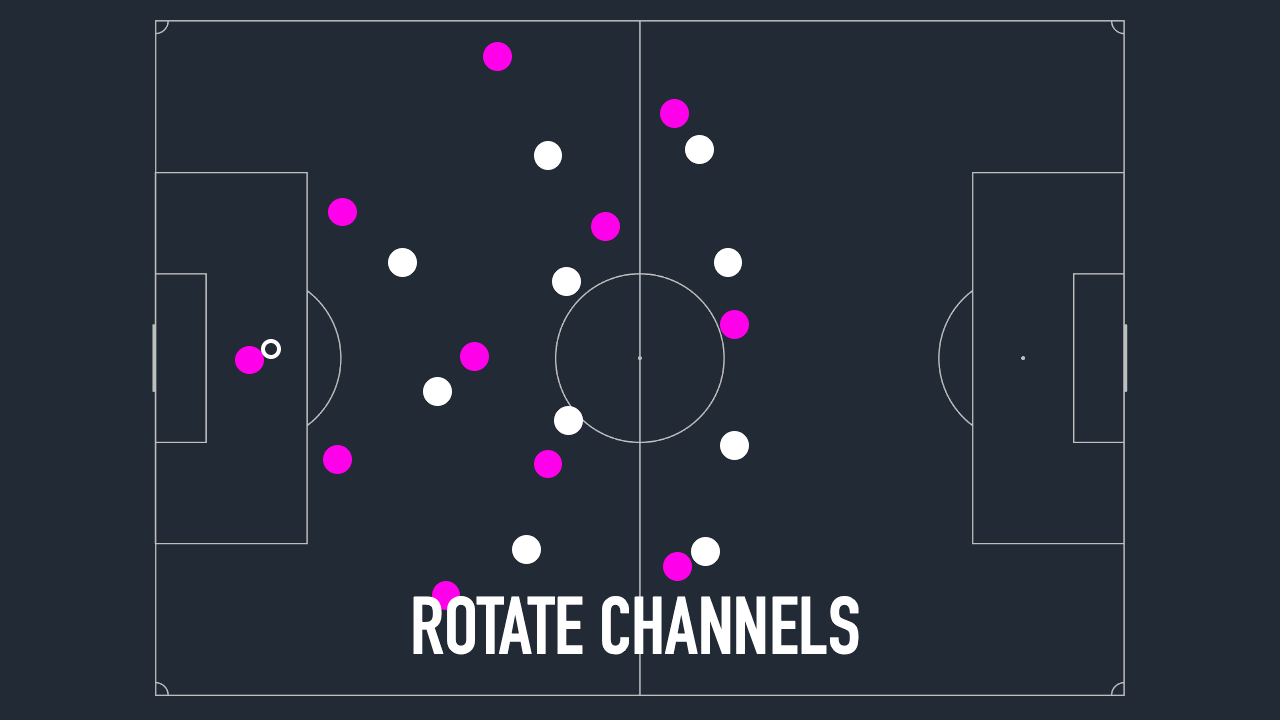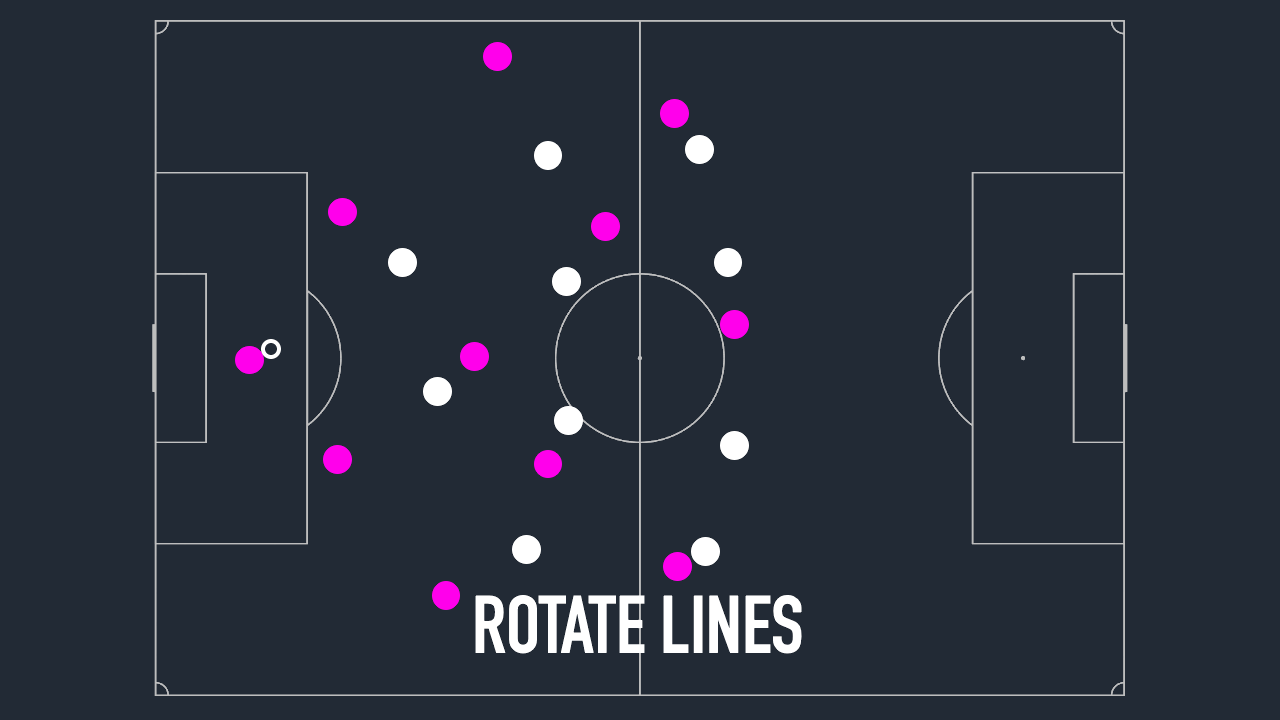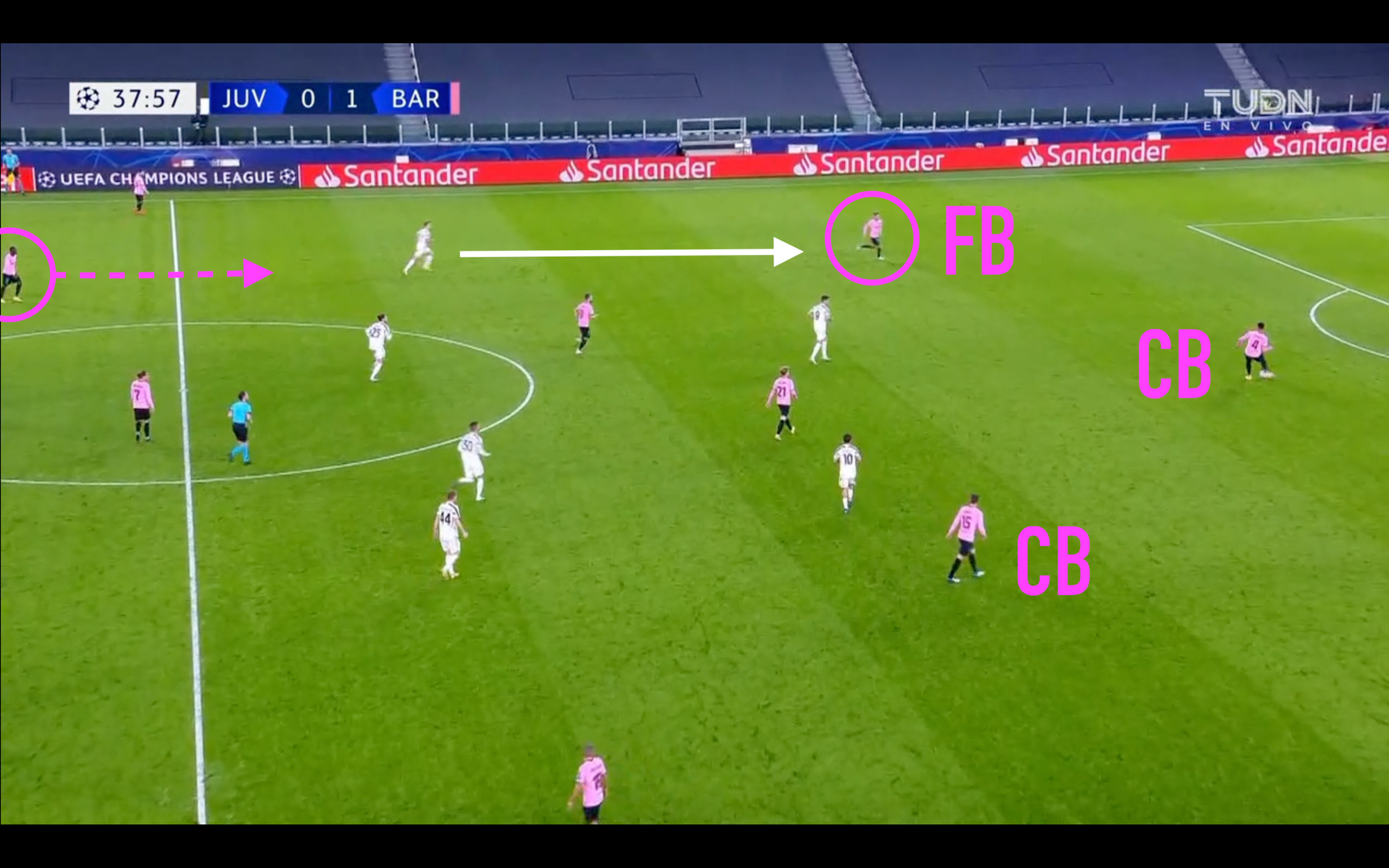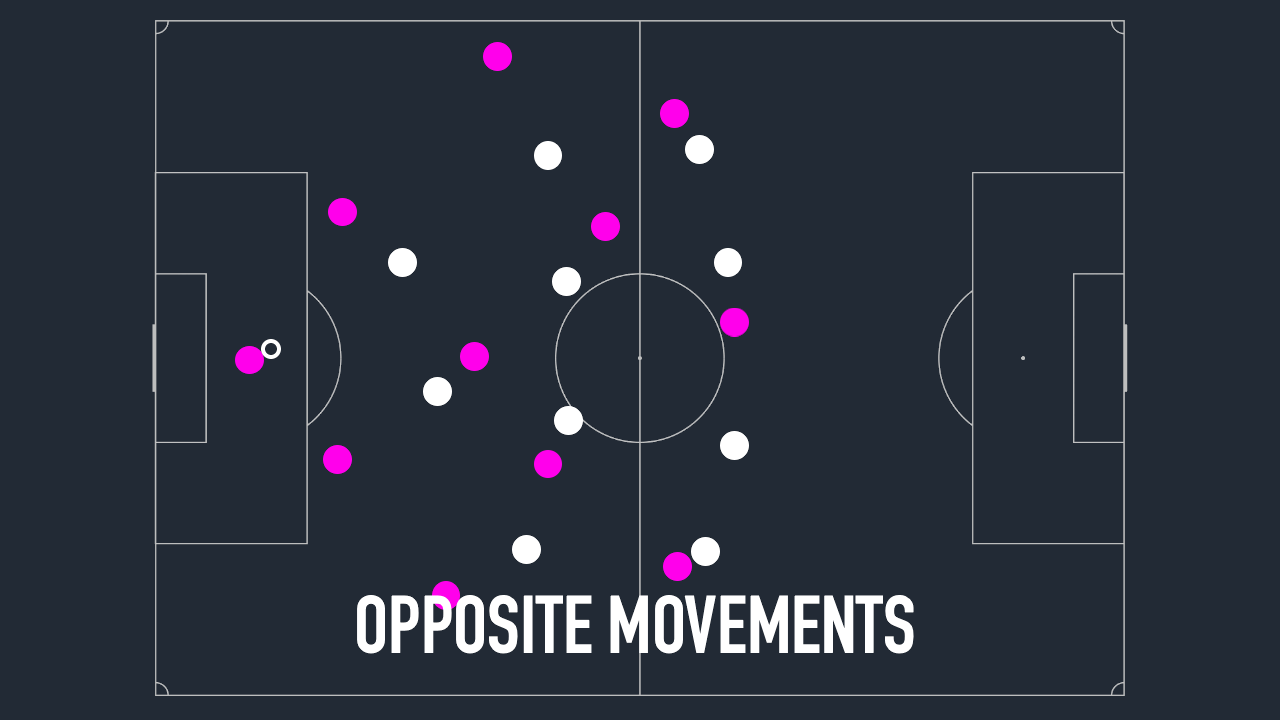
For the next four days, space space space is doing a special series called THE BIG BOOK OF BUILDUPS. It’s a look at the nuts and bolts of buildup tactics in the Champions League group stage. The first two days’ letters will be free for all members; the second two will be for paid socios (you can subscribe here).
Introducing the Big Book of Buildups
The buildup is the best part of soccer. I truly believe this. It’s the only phase of the game where the attack wins the ball, needs to get out of its own half, and actively chooses not to. Most organized buildups start with a pass in the wrong direction. At the same time, the defense, whose entire purpose is to protect its goal, decides to position its players way the hell up the field in the opposition half, leaving their keeper as exposed as possible. It makes no sense. I love this game.
Without mutual recklessness, there is no buildup. If a defense doesn’t want to press, it can hang back in its own half and let the attack walk the ball forward. If the attack doesn’t feel like playing through pressure, it can lob the ball over the top or play direct in transition without worrying about structure. The buildup is a voluntary thing. It’s kind of like a dance in the sense that both partners agree to give and take space through a sequence of carefully rehearsed steps at close quarters, and also in the sense that, like dancing, almost everybody sucks at it.
When I decided to do a survey of Champions League buildup tactics, I made some executive decisions to try to keep things interesting. First, I would stick to reviewing first halves, when legs are fresh and there’s time on the clock and nobody’s too desperate to get to goal. Second, I would analyze the 15 best games from group stage, on the theory that absolutely nobody west of the Danube gives a shit what happened in Ferencváros-Dinamo Kiev, and even if you did care about a game like Manchester City-Marseille, it wouldn’t involve much buildup play worth analyzing. (Trust me, I actually did wind up reviewing that one. There was a two-and-a-half minute sequence of uninterrupted open play in the first half where City completed 54 passes just for fun while Marseille, down a goal, didn’t even sniff the ball.)
Even in the 15 best matchups of the first half of group stage, buildup play wasn’t that common. My rough edit clocked in at 95 minutes of buildups out of 675 official minutes of soccer, which comes out to something like 20% of the time the ball is actually in play. Of that, less than half an hour was what I’d call genuinely organized buildups—passages where the team in possession showed ideas about how it wanted to work the ball forward besides relying on talent to dribble defenders, win second balls, or just kind of figure something out on the fly.
In some games there weren’t many buildups because one team’s press was so aggressive that the other guys figured they’d rather try their luck playing over the top. Other times there wasn’t much buildup play because one side was just too good at it, and pressing was a losing proposition. But in the most fun matches, the ones where both sides come to play, you could catch glimpses of what exactly the best buildups are doing that makes opponents scared to defend high. And it’s in those glimpses, if you ask me, that we get closest to soccer’s sublime.
Welcome to THE BIG BOOK OF BUILDUPS.
Day 1: Rotation
One of the main problems soccer teams in possession have to solve is that they’re facing the wrong way. Sure, the guy on the ball is pointed toward goal, and maybe a few guys alongside or behind him are too, but to get to goal you generally have to pass it forward to players who are facing backward. Those players need time to receive the ball, turn, and face goal so they can make the next play. They need space.
The defense’s job is to deny them that space, and one of their advantages is that they’re all aimed the right way, toward both the ball and the goal they’d eventually like to score on. Defenders can see the field. They can see—most of the time—who they’re supposed to mark or screen or close down when the press is triggered. What the attack really wants to do is rearrange the defense so that they’re moving and looking the wrong way as the ball is passed forward to a player in space.
That’s what rotation is all about. As I’ll use the term here, “rotation” just means a movement by an attacking player off the ball from one area of the field to another in order to either lose a defender or drag him out of position. A lot of the time rotations involve position swaps, but not necessarily. We’ll look at the three basic ways they can work: rotation between channels, rotation between lines, and synchronized opposite movements.
Rotating Channels

The simplest kind of rotation is moving sideways. It doesn’t sound like much, but this creates problems for defenses because they’re forced to stay aware of their blind side and time their switches just right. Go ask any parents who’ve ever tried to play zone on a toddler how easy that is. Truth is, we talk about defensive schemes in soccer as “zonal” or “man oriented,” but in practice your typical upfield block operates somewhere between the two, which means you can usually lead defenders around a little bit to see how far they’ll be dragged out of shape before they decide you’re somebody else’s assignment now. That moment of indecision is what attackers live for, and it’s easiest to find in the channels, the empty gutters of space between defenders.
Since channel-switching is most effective when done by receivers, not passers, and by moving behind markers’ backs, rather than in front of them, it’s rare to see this kind of movement from defenders in possession but almost mandatory for strikers, who are constantly weaving between channels in the buildup. In midfield, you’ll most often see lateral movement from teams that keep a classic No. 10 between the lines, like Lionel Messi in Ronald Koeman’s Barcelona. Diogo Jota provided a more active version of the same as a center forward who dropped under his wingers to work side to side between the lines for Liverpool against Atalanta. As for inverted wingers, which is most wingers these days, it’s de rigueur to rotate channels by providing width at some points in the buildup and coming inside to receive at others. This works especially well in combination with a fullback who’s also comfortable varying his width, like Ferland Mendy underlapping on the left for Real Madrid against Gladbach.
You don’t see a lot of moves across channels in isolation. Teams try to avoid stacking players in the same channel, which would clog lanes, so you’re usually going to see these lateral movements as part of a switch between two attackers headed in opposite directions. Don’t worry, we’ll get to that.
Rotating Lines

Just like moving east-west across channels puts pressure on defenders to figure out who’s marking who, moving north-south from one line to another can drag markers out of position and force decisions. Strikers like Liverpool’s Roberto Firmino and Real Madrid’s Karim Benzema are comfortable dropping deeper than center backs are willing to follow, and Gian Piero Gasperini’s high-octane Atalanta attack doesn’t use a striker at all, only two wide forwards who often rotate into deeper positions in the team’s wide diamonds. That can help create options to play forward in the buildup. So can fullbacks who push up the wings or wingers who drop to receive. This kind of rotation between the second and third lines is especially important when you get up around the opponent’s box.
In the buildup, though, the thing you really want to figure out is how to get a free man on the first line who'll have time to pick out a linebreaking pass. Most of the time that’s going to involve rotating an extra player down a line to join the center backs. This is a numbers game. When an opponent presses with just one forward against two center backs, like RB Salzburg did against Bayern Munich, the center backs don’t need reinforcements. But when it’s two forwards pressing, like Bayern saw from Atlético Madrid, now the center backs need a third player to join them.
One move that Joshua Kimmich will sometimes do for Bayern, and which Sergio Busquets helped popularize at Barcelona, is dropping a defensive midfielder between the center backs. This is known as the salida lavolpiana (if you’re curious, I wrote a whole thing about it that’s linked in the Further Reading section down below). Watching this year’s group stage games, I got the feeling the lavolpiana is sliding out of vogue. Is it because it’s too straightforward, too easy for defenses to keep track of? Or because it means the free man on one side of the back line will be a center back instead of a better-passing midfielder or fullback? I’m not sure, but most teams now seem to prefer dropping one of those players outside the center backs, who shift over to accommodate.

Some coaches design a whole buildup style around a hybrid fullback-center back, as Andrea Pirlo has done with Danilo at Juventus and Koeman’s been trying with Sergi Roberto at Barcelona. Kyle Walker does a lot of this for City, too. If this were a Hottest Fall Trends of 2020 piece, though, I’d say this season’s must-have accessory is a midfielder who likes to drop into the outside pocket between a center back and a fullback to start the buildup. Weirdly, Frenkie de Jong, who helped popularize this move at Ajax a couple years ago, doesn’t drop outside from midfield that much anymore (which may be why he’s been playing as an out-and-out center back in recent weeks). But you’ll still see it a lot from Toni Kroos at Real Madrid, Rodri at City, and whoever the hell Shakhtar Donetsk’s midfielders were when they were making Madrid’s press look silly the other week. Most of all, you'll see it from Thomas Tuchel’s Paris Saint Germain, where they’ve made the line-dropping center mid a religion.
Opposite Movements

I’m a little nervous to be on the wrong side of Arrigo Sacchi, who last week declared that “we don’t see a lot of automatisms at PSG” and judged them “a team not based on harmony and beauty,” but in my non-Hall-of-Fame-manager opinion Tuchel’s buildups are a joy to watch. It’s true that PSG has struggled a little bit in one of this year’s toughest Champions League groups, especially in second halves, but they’ve also been playing a meaningful match like every day for four months so let’s maybe cut them a little slack, Arrigo.
Anyway, whatever PSG’s problem has been, it’s not the buildup. Tuchel’s team is very good at the hardest kind of rotation: coordinating opposite movements between players in different lines and channels at the same time, which is honestly just rude to defenders who are out there trying their best.
It starts with one or both central midfielders in the 4-3-3 dropping outside the center backs (we’ll use positions instead of names since the midfield lineup’s always changing). This triggers a triangular rotation: as the midfielder invades his fullback’s turf, the fullback moves up the wing, while the winger heads inside to where the center mid used to be. Just think about all the problems this causes for the defense. The guy who was marking the center mid can’t follow him out to the flank without leaving a hole in midfield where the winger can receive; the fullback who was marking the winger can’t follow him into midfield because PSG’s fullback is already headed up the sideline; and if the midfielder who was shadowing that fullback chases him instead of switching onto the center mid who’s now in his place, PSG will have a player in space who can carry the ball forward and pick out a linebreaking pass. To make things worse, PSG also has the option of stopping its fullback halfway up the sideline and letting the striker drag across into that empty wing space instead. It’s just too many moving parts to keep track of.
If you’ve ever wondered what positional play looks like, it’s this. Instead of staying in their assigned positions in a formation, players are constantly making opposite movements—one moving in while the other goes out, one pushing up while the other drops down—that create spaces and fill them from unexpected angles. Timing is key, but a team that can synchronize its opposite movements is almost guaranteed to find a player in space on the next line with time to turn. And that, ladies and gentlemen, is how a good team builds up. ❧
Thanks for reading space space space! Coming tomorrow, Day 2: pass-and-move combinations in the buildup. If you'd like to receive all four days of THE BIG BOOK OF BUILDUPS, subscribe here to become a socio.
Further reading:
- Josh Manley, What Possession Shapes Do Europe’s Top Teams Use? (Between the Posts)
- JD, Tactical Theory: The Various Methods of Dismarking (Spielverlagerung)
- John Muller, Let's Talk About the Salida Lavolpiana (The Outfield)
Image: Robert Smithson, Spiral Jetty (photo by Todd Hakala)
Sign up for space space space
The full archive is now free for all members.